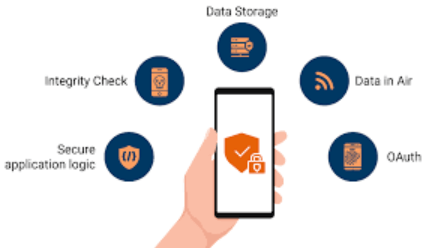Tips for Enhancing App Security

In the current digital age, mobile applications are taking center stage in personal as well as professional realms. However, as the popularity of apps increases, the problems related to application security are also growing. Hackers are never short of ideas of how to find and exploit software vulnerabilities and, as a result, gain unauthorized access to people’s sensitive data.
The security of the app is one of the key factors that the developers should pay attention to. Here are some tips by AppSealing that can help enhance the security of your mobile app:
- Follow industry standards.
One of the first things to keep in mind is standardizing app security in the industry. One of these is the use of secure authentication mechanisms, encryption of data transmission, certificate pinning, and other prescribed practices by operating systems and app stores. Following the industry standards ensures that you stick to the basics of security for apps.
- Perform threat modeling.
Threat modeling is the process of discovering potential security threats, vulnerabilities, and risks that can be associated with the app. Then, you will have a picture of the risks, and you will develop mitigation strategies. A threat model covers aspects such as user roles, data flow, server-side controls, and other features that have a bearing on the security of the app. It is through this exercise that we get a grasp of how to build security.
- Analyze third-party dependencies.
Most apps use third-party libraries, SDKs, and APIs. Analyzing them from a security lens is critical, as vulnerabilities in third-party code can expose your app. So apart from assessing your own code, you need to closely evaluate all external dependencies. Check for the use of outdated libraries, permission issues, encryption quality, and other associated risks. This will give you an idea of the additional security controls needed.
- Carry out penetration testing.
No app security strategy is complete without performing penetration testing. This involves subjecting your app to deliberate attacks to uncover vulnerabilities. Ethical hackers are hired to conduct penetration tests using tools and techniques that actual hackers might use. The reports from penetration testing provide insights into loopholes that need to be plugged. This is an important validation of your app’s security posture.
- Adopt a zero-trust approach.
The zero trust model is centered around the concept of “never trust, always verify.” It mandates that no user or device is inherently trusted. Every access request needs to be authenticated and authorized. Adopting a zero-trust approach entails that proper identity verification and access management controls are implemented in your app. This minimizes exposure to weak links arising out of implicit trust.
- Limit the use of sensitive permissions.
Mobile apps need certain permissions to access device data like contacts, location, microphone, etc. However, many apps ask for more permissions than are needed. The principle of least privilege should be followed while requesting permissions in your app. Only permissions that are absolutely necessary for the app should be asked for. This reduces the attack surface for malicious actors.
- Employ encryption best practices.
Encryption is fundamental for securing sensitive user data such as financial information, credentials, messages, files, etc. Proper encryption practices need to be adopted, covering aspects like secure algorithms, key management, key length, mode of encryption, etc. Also, sensitive data should be encrypted not just during transmission but also in storage within the device. This enhances security against data theft and tampering attacks.
- Adopt Security by Design Principles
Security should be ingrained in the entire lifecycle of app design and development. Rather than considering it an afterthought, security should be a foundational component touching all stages of ideation, coding, testing, release, and updates. This requires security training for developers, threat modeling exercises, the use of static and dynamic analysis tools, security testing, etc. Adopting security by design principles greatly bolsters app security.
- Implement runtime application self-protection.
Runtime Application Self Protection (RASP) provides real-time monitoring of app behavior to identify and block anomalous activities. RASP solutions add sensors to an app to detect issues like SQL injections, cross-site scripting, buffer overflows, etc. at runtime. By detecting malicious activities, the attack can be terminated in real-time. RASP helps fortify defenses against zero-day and unknown threats.
- Avoid hard-coding secrets.
Developers often make the mistake of hardcoding secret keys, passwords, and other sensitive information within the app code. This exposes critical credentials that can be exploited. The recommended approach is to store secrets outside the app, on the server side. They should also be encrypted and their access controlled via policies. Avoiding hardcoded secrets is a simple yet powerful way to make apps more secure.
- Leverage automated scanning tools.
The software ecosystem provides multiple handy tools that allow automated scanning of mobile app binaries to detect security issues. These tools can detect vulnerabilities like insecure data storage, insufficient transport layer protection,weak encryption schemes, etc. The use of automated analyzers complements manual reviews and allows scalable app security both during development and after release.
- Plan for Security Updates
App security requires vigilance not just before release but also after the app is live. As new vulnerabilities are discovered, security patches and fixes need to be issued. So your app release cycles must accommodate security updates based on the evolving threat landscape. Planning ahead for security updates ensures your users always have the latest security protections.
- Educate users about app permissions.
Users are often prompted to grant various permissions when installing or using an app. Educating users about the implications of allowing or denying permissions from a security standpoint is important. They should be cautious of apps seeking excessive permissions without valid reasons. Also, advising users not to grant permissions when prompted by external browsers can help prevent phishing attacks.
Conclusion
Mobile apps are prime targets for hackers, given the treasure trove of personal data they hold and their ubiquitous usage. Developing secure apps has assumed critical importance given the sheer numbers of users and the sensitivity of the data at risk. This calls for security consciousness throughout the entire app lifecycle. Developers must adopt best practices covering threat modeling, secure coding guidelines, encryption, rigorous testing, obscuring code logic, and continuous monitoring. Leveraging proven techniques like AppShielding and RASP helps boost runtime security.




